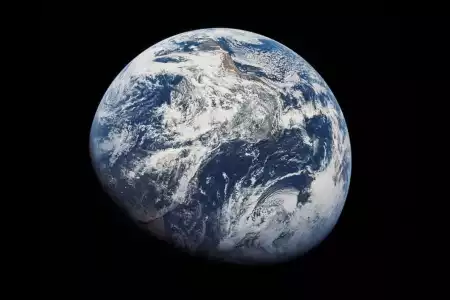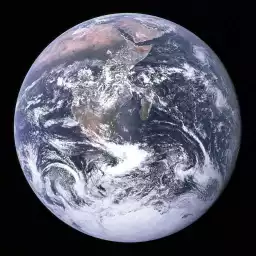 This iconic photo, capturing the entire Earth from about 30,000 km away, is among the first taken by humans. Likely snapped by Bill Anders of Apollo 8's crew, it offers a stunning distant view of our planet. U.S. govt., Public domain
This iconic photo, capturing the entire Earth from about 30,000 km away, is among the first taken by humans. Likely snapped by Bill Anders of Apollo 8's crew, it offers a stunning distant view of our planet. U.S. govt., Public domain
The Planet Earth Quiz
How much do you know about Earth?
Embark on a journey around our magnificent home planet in The Planet Earth Quiz! From towering mountains to the depths of the oceans, test your knowledge on Earth's wonders. Are you ready to explore the secrets of this blue marvel we call home? Let's start the adventure!
Start the Planet Earth quiz
Questions and answers about Planet Earth
-
What percentage of Earth's surface is covered in water?
About 71% of the Earth's surface is covered in water, a testament to our planet's unique quality in the solar system, predominantly in the form of oceans.
- 71%
- 65%
- 50%
- 80%
-
What is Earth's atmosphere composed of?
Earth's atmosphere is primarily composed of nitrogen (78%) and oxygen (21%), with traces of other gases like argon and carbon dioxide.
- Nitrogen and Oxygen
- Hydrogen and Helium
- Oxygen and Carbon Dioxide
- Argon and Neon
-
How old is Earth?
Earth is estimated to be about 4.54 billion years old, based on evidence from radiometric age dating of meteorite material and Earth's rocks.
- 4.54 billion years
- 3.8 billion years
- 5 billion years
- 2.5 billion years
-
What causes Earth's seasons?
Earth's seasons are caused by its axial tilt of about 23.5 degrees, which leads to variations in sunlight distribution over the planet during its orbit around the Sun.
- Axial Tilt
- Distance from the Sun
- Changes in Earth's orbit
- Solar intensity fluctuations
-
What is the deepest part of Earth's oceans?
The Challenger Deep in the Mariana Trench is the deepest part of Earth's oceans, reaching depths of about 36,070 feet (10,994 meters), located in the western Pacific Ocean.
- Challenger Deep in the Mariana Trench
- Sirena Deep in the Tonga Trench
- Galathea Depth in the Philippine Trench
- Milwaukee Deep in the Puerto Rico Trench
-
What is the diameter of Earth?
The Earth's diameter is approximately 12,742 kilometers (7,918 miles), a measurement that plays a crucial role in understanding our planet's scale and structure.
- 12,742 kilometers
- 10,000 kilometers
- 15,321 kilometers
- 8,849 kilometers
-
How long does it take for the Earth to rotate once on its axis?
Earth completes one rotation on its axis approximately every 24 hours, a fundamental time cycle that defines the length of a day on our planet.
- 24 hours
- 12 hours
- 36 hours
- 48 hours
-
What is the Earth's primary source of energy?
The Sun is the primary source of energy for Earth, providing the essential light and heat that sustain life and drive the planet's climate and weather systems.
- The Sun
- Geothermal energy
- Wind energy
- The Moon
-
How much of Earth's water is fresh water?
About 2.5% of Earth's water is fresh water, crucial for human consumption, agriculture, and ecosystems, with the majority locked in glaciers and ice caps.
- 2.5%
- 10%
- 50%
- 1%
-
What causes ocean tides on Earth?
Ocean tides on Earth are primarily caused by the gravitational pull of the Moon, and to a lesser extent the Sun, influencing the rise and fall of sea levels.
- Gravitational pull of the Moon
- Earth's rotation
- Solar winds
- Underwater earthquakes
-
What is the name of Earth's largest continent?
Asia is Earth's largest continent, both in terms of size and population, encompassing a diverse range of cultures, climates, and landscapes.
- Asia
- Africa
- North America
- Europe
-
How does the greenhouse effect work on Earth?
The greenhouse effect occurs when Earth's atmosphere traps solar radiation, caused by gases such as carbon dioxide, methane, and water vapor that allow sunlight in but keep the heat from escaping.
- Trapping solar radiation by atmospheric gases
- Reflection of solar radiation by the atmosphere
- Absorption of sunlight by the oceans
- Heat generation from Earth's core
-
What are the layers of the Earth's atmosphere?
Earth's atmosphere is composed of five main layers: the Troposphere, Stratosphere, Mesosphere, Thermosphere, and Exosphere, each with distinct characteristics.
- Troposphere, Stratosphere, Mesosphere, Thermosphere, Exosphere
- Troposphere, Mesosphere, Ionosphere, Exosphere
- Stratosphere, Asthenosphere, Mesosphere, Exosphere
- Biosphere, Lithosphere, Hydrosphere, Atmosphere
-
What are the predominant rock types in the Earth's crust?
The Earth's crust is primarily composed of two types of rocks: granite in the continental crust and basalt in the oceanic crust.
- Granite and basalt
- Limestone and marble
- Iron and nickel
- Sandstone and clay
-
What geological processes shape Earth's surface?
Various geological processes shape Earth's surface, including erosion by wind, water, and ice, volcanic activity, earthquakes, and the movement of Earth's plates. Each process plays a significant role in altering the landscape.
- Erosion, volcanic activity, plate movement
- Continental drift, river formation
- Glacier movement, solar radiation
- Atmospheric pressure, ocean currents
-
What percentage of Earth's oxygen is produced by the Amazon rainforest?
The Amazon rainforest contributes about 6% to 9% of the total oxygen produced through photosynthesis worldwide. Although it plays a significant role in Earth's oxygen cycle, recent studies have debunked the old myth of it being the "lungs of the planet" that was responsible for 20% of Earth's oxygen.
- 6-9%
- 10-15%
- 20%
- 30%
-
What is the theory of Earth's moon formation?
The most widely accepted theory of Earth's moon formation is the Giant Impact Hypothesis, which suggests that the Moon formed from the debris left after a Mars-sized body collided with Earth.
- Giant Impact Hypothesis
- Co-formation Theory
- Capture Theory
- Binary Accretion Theory
-
How does Earth's magnetic field protect the planet?
Earth's magnetic field protects the planet by deflecting solar wind and cosmic radiation, preventing them from stripping away the atmosphere and harming life on Earth.
- Deflecting solar wind and cosmic radiation
- Absorbing solar energy
- Generating atmospheric heat
- Creating gravitational pull
-
What are the major factors contributing to Earth's climate change?
Major factors contributing to Earth's climate change include greenhouse gas emissions, deforestation, and fossil fuel burning, which increase the planet's temperature.
- Greenhouse gas emissions, deforestation, fossil fuel burning
- Solar variations, volcanic eruptions
- Ocean currents changes, lunar cycles
- Continental drift, asteroid impacts
-
What is the process of photosynthesis and its importance to Earth?
Photosynthesis is a process where plants, algae, and some bacteria convert sunlight, carbon dioxide, and water into oxygen and energy. This process is vital for producing oxygen for living organisms to breathe and for reducing atmospheric carbon dioxide, thus helping to regulate Earth's climate.
- Conversion of sunlight, CO2, and water into oxygen and energy
- Absorption of CO2 and release of nitrogen
- Conversion of water vapor and sunlight into oxygen
- Absorption of sunlight and release of carbon dioxide
-
What are Earth's polar ice caps, and why are they significant?
Earth's polar ice caps, located at the poles, are massive sheets of ice. They significantly regulate global climate, reflect sunlight, and store a large amount of the world's freshwater.
- Massive ice sheets regulating global climate
- Mountainous regions with permanent snow
- Frozen layers in the upper atmosphere
- Areas of permafrost in polar regions
-
How do earthquakes occur?
Earthquakes occur due to the movement of tectonic plates in the Earth's crust, which can cause a sudden release of energy, resulting in seismic waves that shake the ground.
- Movement of tectonic plates
- Volcanic activity
- Gravitational pull from the moon
- Changes in atmospheric pressure
-
What is the significance of the ozone layer for Earth?
The ozone layer is crucial for life on Earth as it absorbs the majority of the sun's harmful ultraviolet rays, protecting living organisms from these damaging effects.
- Absorbs harmful ultraviolet rays
- Regulates Earth's temperature
- Produces oxygen
- Traps greenhouse gases
-
What are the primary causes of Earth's weather patterns?
Earth's weather patterns are primarily caused by the distribution of solar energy, which is affected by factors like atmospheric pressure, ocean currents, and geographical features.
- Distribution of solar energy and atmospheric pressure
- Earth's magnetic field
- Movement of the Earth's moon
- Volcanic eruptions
-
What are the most significant threats to Earth's biodiversity?
Significant threats to Earth's biodiversity include habitat destruction, climate change, pollution, invasive species, and overexploitation of resources.
- Habitat destruction, climate change, pollution
- Natural disasters
- Changes in the Earth's orbit
- Solar radiation variations
 Harrison Schmitt, Public domain, via Wikimedia Commons
Harrison Schmitt, Public domain, via Wikimedia Commons
About the Planet Earth
Our Dynamic Home in the Cosmos
Planet Earth, a unique celestial body in the vast expanse of the cosmos, stands out as the only known planet to support life. With its remarkable blend of diverse ecosystems, Earth hosts an incredible array of flora and fauna.
A Delicate Balance
At its core, Earth is a dynamic planet, constantly undergoing changes both visible and imperceptible. It’s this dynamism that sustains life. The process of photosynthesis, for example, showcases this beautifully - plants convert sunlight into energy, releasing oxygen, which is vital for most life forms. Meanwhile, the continual movement of tectonic plates reshapes continents and ocean floors, leading to the creation of mountains, valleys, and deep ocean trenches.
Water: The Essence of Life
Water covers about 71% of Earth’s surface, predominantly in the form of oceans, seas, and ice caps. This abundance of water is a key factor that sets Earth apart in the solar system and is crucial for the survival of countless species.
Climate: A Complex Symphony
Earth's climate system is a complex interplay of atmospheric conditions, ocean currents, and solar radiation. This system, driven by the sun's energy, dictates weather patterns, regulates temperatures, and ultimately shapes life on our planet.
Human Impact and Future Challenges
As dominant inhabitants, humans have a profound impact on Earth’s environment. While we've made remarkable technological and cultural advancements, this progress comes with challenges. Climate change, driven by human activities, is altering Earth's natural balance, calling for urgent, collective action to preserve our planet for future generations.
Preserving Earth's Legacy
As we continue to explore and understand Earth's intricate systems, it becomes clear that living in harmony with our planet is not just a choice, but an essential part of ensuring a sustainable future for all forms of life.